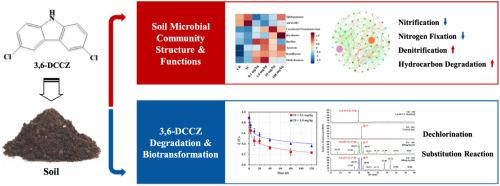Journal of Hazardous Materials ( IF 12.2 ) Pub Date : 2021-09-25 , DOI: 10.1016/j.jhazmat.2021.127315 Baihui Shi 1 , Chao Cheng 1 , Yuanqing Zhang 1 , Zhongkun Du 1 , Lusheng Zhu 1 , Jun Wang 1 , Jinhua Wang 1 , Bing Li 1

|
The emerging contaminants polyhalogenated carbazoles (PHCZs) have been verified to be present in soils and sediments globally, and they show dioxin-like toxicity. However, there is a lack of soil ecological risk assessments on PHCZs despite their high detection rate and concentration in soils. The present study investigated the degradation and soil microbial influence of 3,6-dichlorocarbazole (3,6-DCCZ, a frequently detected PHCZ) in soil. The results showed that the half-lives of 3,6-DCCZ at concentrations of 0.100 mg/kg and 1.00 mg/kg were 7.75 d and 16.73 d, respectively. We found that 3,6-DCCZ was transformed into 3-chlorocarbazole (3-CCZ) by dehalogenation in soil. Additionally, intermediate products with higher molecular weights were detected, presumably because the -H on the carbazole ring was replaced by -CH3, -CH2-O-CH3, or -CH2-O-CH2CH3. 3,6-DCCZ exposure slightly increased the soil bacterial abundance and diversity and clearly changed the soil bacterial community structure. Through a comprehensive analysis of FAPROTAX, functional gene qPCR and soil enzyme tests, we concluded that 3,6-DCCZ exposure inhibited nitrification and nitrogen fixation but promoted denitrification, carbon dioxide fixation and hydrocarbon degradation processes in soil. This study provides valuable data for clarifying the PHCZ ecological risk in soil.
中文翻译:

3,6-二氯咔唑对土壤微生物生态及其降解的影响
新出现的污染物多卤代咔唑(PHCZs)已被证实存在于全球土壤和沉积物中,它们表现出类似二恶英的毒性。然而,尽管 PHCZs 在土壤中的检出率和浓度很高,但缺乏对 PHCZs 的土壤生态风险评估。本研究调查了土壤中 3,6-二氯咔唑(3,6-DCCZ,一种经常检测到的 PHCZ)的降解和土壤微生物影响。结果表明,3,6-DCCZ在0.100 mg/kg和1.00 mg/kg浓度下的半衰期分别为7.75 d和16.73 d。我们发现 3,6-DCCZ 在土壤中通过脱卤作用转化为 3-氯咔唑 (3-CCZ)。此外,检测到具有较高分子量的中间产物,推测是因为咔唑环上的-H被-CH 3取代、-CH 2 -O-CH 3或-CH 2 -O-CH 2 CH 3。3,6-DCCZ暴露略微增加了土壤细菌丰度和多样性,明显改变了土壤细菌群落结构。通过对 FAPROTAX、功能基因 qPCR 和土壤酶检测的综合分析,我们得出结论,3,6-DCCZ 暴露抑制了土壤中的硝化和固氮,但促进了反硝化、二氧化碳固定和碳氢化合物降解过程。本研究为阐明土壤中的PHCZ生态风险提供了有价值的数据。































 京公网安备 11010802027423号
京公网安备 11010802027423号